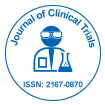
Journal of Clinical Trials
Open Access
ISSN: 2167-0870

ISSN: 2167-0870
Case Report - (2017) Volume 7, Issue 2
The dermatological adverse effects due to the association of interferon Alpha and ribavirin in patients treated for hepatitis C are becoming more frequent but little is known about them. Such adverse effects range from eczema to the onset or the exacerbation of a pre-existing autoimmune disease. This may influence the therapeutic management of such patients.
Keywords: Erythroderma; Hepatitis C; Interferon alpha 2a; Ribavirin
Several cutaneous adverse effects have been described following the use of interferon (IFN) alpha 2a combined with Ribavirin in patients treated for hepatitis C. We report a case of erythroderma that has never been previously described in the literature.
A 73-year-old man with a history of Hepatitis C for the past two years received 6 months of treatment with a combination of ribavirin capsules, 600 mg orally twice daily, and recombinant PEGylated interferon (PegINF) alpha-2a at a dose of 180 μg once weekly in subcutaneous injection. A week before completing his treatment, the patient noticed generalized pruritus associated with skin infiltrations. Clinically, dry pruritic erythroderma with digitiform infiltrated areas on the skin of the back and wrists were observed as well as infiltration of the scalp giving a cerebriform appearance (Figures 1 and 2).
Further examination found skin cracks on the hand and feet with an erosive cheilitis (Figure 3). The rest of the physical examination was noticeable for bilateral axillary lymphadenopathies. The lab studies were remarkable for an inflammatory anaemia with eosinophilia at 1700 elements/IU, lymphopenia at 920 elements/IU, Gamma-glutamyl– transferase at twice normal levels and hypoalbuminemia at 30 g/L. At the cutaneous biopsy, apoptotic bodies were found at the level of the epidermis.
The underlying dermis harbored a perivascular inflammatory infiltrate composed of lymphocytes, histiocytes and polynuclear cells, which were essentially eosinophilic. Lymphocyte exocytosis was noted, we concluded to an allergic reaction. With clinical improvement of the patient under symptomatic treatment and the negative results of the biopsy in search of a cutaneous lymphoma, we retained the diagnosis of drug induced eruptions in response to the association of interferon alfa and ribavirin.
The cutaneous adverse effects of IFN occur frequently and are well known. They occur regardless of the disease being treated. The recent availability of new forms of late acting IFN (PEGylated interferon or PegIFN) and their combination with new molecules particularly ribavirin for the treatment of hepatitis contributes to the emergence or modification of cutaneous adverse effects [1,2]. Such effects may include dry skin, eczema, adverse effects on the hair and nails (telogen effluvium, abnormal coloration, hypertrichosis), vascular events (acrocyanosis, livedo, Raynaud's syndrome, necrosis of the extremities), the appearance or worsening of certain immune dysfunction skin diseases (vitiligo, lichen, psoriasis, lupus, autoimmune bullous diseases) and lesions of cutaneous and visceral sarcoidosis [3-5]. These adverse effects decrease with lowering doses of interferon or when it is discontinued as was the case in our patient. Two months after discontinuation of the suspected drug agent the association of PegINF alpha-2a with ribavirin, we observed marked clinical improvement in our patient who was put on supportive treatment based on an emollient and antihistamines.
In presenting this case, we hope to create awareness for those who prescribe these drug agents. Particular emphasis is put on the association of PEGylated IFN-Ribavirin in the treatment of patients with Hepatitis C with its potentially debilitating side effects on such patients.